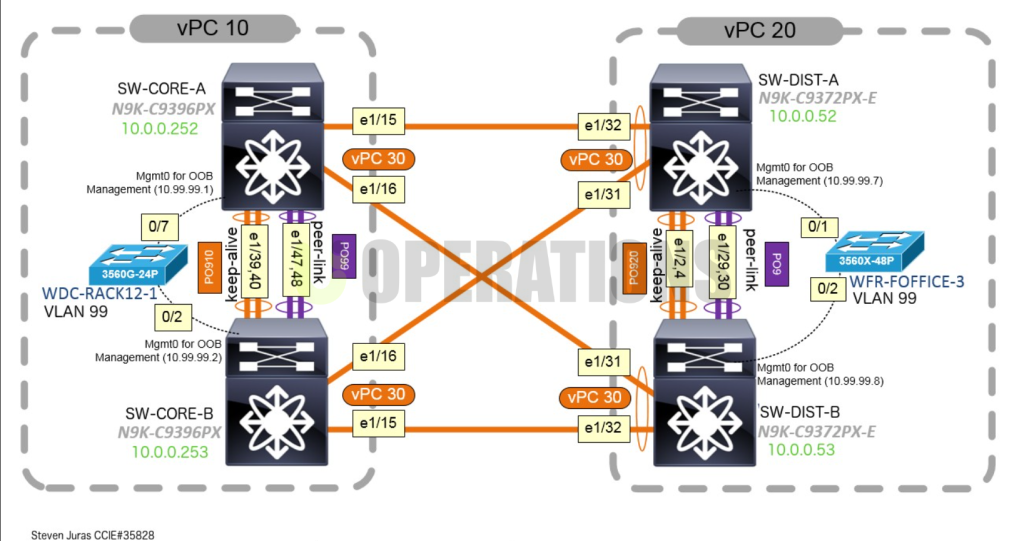Portfolio Details
Nexus VPC Deployment
Price: 1100$
Duration: 2 weeks
01
introduction
This document outlines the deployment process and key considerations for a Nexus Virtual Private Cloud (VPC), which was implemented for a client’s specific infrastructure requirements. The project aimed to create a scalable, secure, and high-performance network environment to meet the client’s business needs.
02
Client Requirements overview
One of the key requirements from the client was to build an isolated and secure network infrastructure for their applications. They needed a VPC solution that would support their growing workloads while maintaining high levels of flexibility, scalability, and security. The client’s environment necessitated an efficient way to manage internal resources, integrate with third-party services, and ensure compliance with organizational security standards.
Specific client requirements included:
- Scalable Infrastructure: The ability to expand network resources quickly to accommodate growing data and application requirements.
- Security and Isolation: A secure environment with proper network segmentation to protect sensitive data and ensure compliance with industry standards.
- High Availability: An architecture that supports fault tolerance and minimizes service disruptions to ensure continuous availability.
- Seamless Integration with Cloud Services: The client required smooth integration with both on-premises and cloud-based services, including databases, load balancers, and storage solutions.
- Optimized Performance: The infrastructure should be capable of handling high-volume traffic without compromising on performance.
- Compliance and Auditing: Compliance with regulatory frameworks was a key requirement, necessitating detailed auditing and logging features to meet internal governance policies.
03
Nexus VPC Architecture Design
The Nexus VPC deployment followed a highly customized architecture to meet the client’s needs. The VPC was designed to offer isolated environments that would house the client’s critical applications and ensure proper network segmentation.
Key Components of the Nexus VPC Architecture:
- VPC Segmentation:
- The VPC was divided into multiple subnets based on application tiers, which provided isolation between development, staging, and production environments.
- Public and private subnets were created to handle different types of traffic: public-facing services were deployed in the public subnet, while private services were deployed in the private subnet to increase security.
- Security Groups and Network ACLs:
- Security groups were configured to restrict access to resources based on trusted IP ranges and ports, while Network ACLs provided an additional layer of security at the subnet level.
- A zero-trust approach was enforced, ensuring that internal traffic was scrutinized and only authorized applications and users could access the resources.
- Internet Gateway and VPN:
- An Internet Gateway was deployed to allow communication with external services and the internet. A Virtual Private Network (VPN) was set up for secure site-to-site communication between the client’s on-premises infrastructure and the Nexus VPC.
- Load Balancing and Auto Scaling:
- Elastic Load Balancers (ELBs) were integrated into the design to distribute incoming traffic efficiently across application servers.
- Auto Scaling policies were defined to dynamically adjust the number of instances based on traffic patterns, ensuring high availability and optimal resource utilization.
- PrivateLink for Secure Service Communication:
- The client required secure communication between services within the VPC and third-party services. AWS PrivateLink was deployed to facilitate secure and private connectivity without traversing the public internet.
- Monitoring and Logging:
- AWS CloudWatch and CloudTrail were utilized to monitor resource performance, manage logs, and detect any unusual activity, which was critical for compliance.
- The client’s internal auditing processes required granular monitoring of network traffic, resource provisioning, and user access.
- VPC Peering and Transit Gateway:
- VPC Peering was implemented between different VPCs within the organization for internal communication, ensuring secure and efficient data flow between the different environments.
- The Transit Gateway was configured to simplify connectivity between multiple VPCs and on-premises data centers.
04
Deployment Process
- Initial Setup:
- The deployment started with the creation of a base VPC, followed by the setup of subnets, route tables, and internet gateways. Security groups and NACLs were created in parallel to enforce network security policies.
- Service Integration:
- Key services such as databases, application servers, and storage were deployed within the private subnets, and external services were integrated via VPC endpoints or AWS PrivateLink.
- Load balancers were set up to distribute traffic and ensure high availability, while auto-scaling policies were configured to handle fluctuations in demand.
- Security Hardening:
- The security posture of the deployment was strengthened through the application of best practices, including encryption of data at rest and in transit, role-based access controls, and detailed audit logging.
- Testing and Validation:
- Extensive testing was performed to validate the network architecture, performance, and security controls. Load testing and failover testing were conducted to ensure high availability and scalability.
- Ongoing Monitoring and Optimization:
- Continuous monitoring and performance optimization were implemented to address any potential issues and improve network efficiency.
05
Challenges and Mitigations
Several challenges were encountered during the Nexus VPC deployment:
- Network Complexity: The segmentation of different environments (e.g., production, staging) created a complex network configuration. This was mitigated by using clear naming conventions and automation scripts to ensure consistency.
- Latency Concerns: Integration with external services created potential latency issues. To address this, we leveraged AWS PrivateLink for low-latency, secure connections to third-party services.
- Security Considerations: Ensuring a robust security posture was a primary concern. The deployment followed a strict Zero Trust security model, implementing multi-layered defenses including encryption, security groups, and fine-grained IAM roles.
06
conclusion
The Nexus VPC deployment successfully met the client’s requirements by providing a secure, scalable, and highly available infrastructure solution. By following best practices in network segmentation, security, and cloud service integration, the client now has a reliable platform that supports its growing business needs.
This deployment also set the foundation for future scalability, as the infrastructure was designed to accommodate new services, applications, and workloads. The client can now confidently rely on the network for seamless service delivery and high-performance operations.


